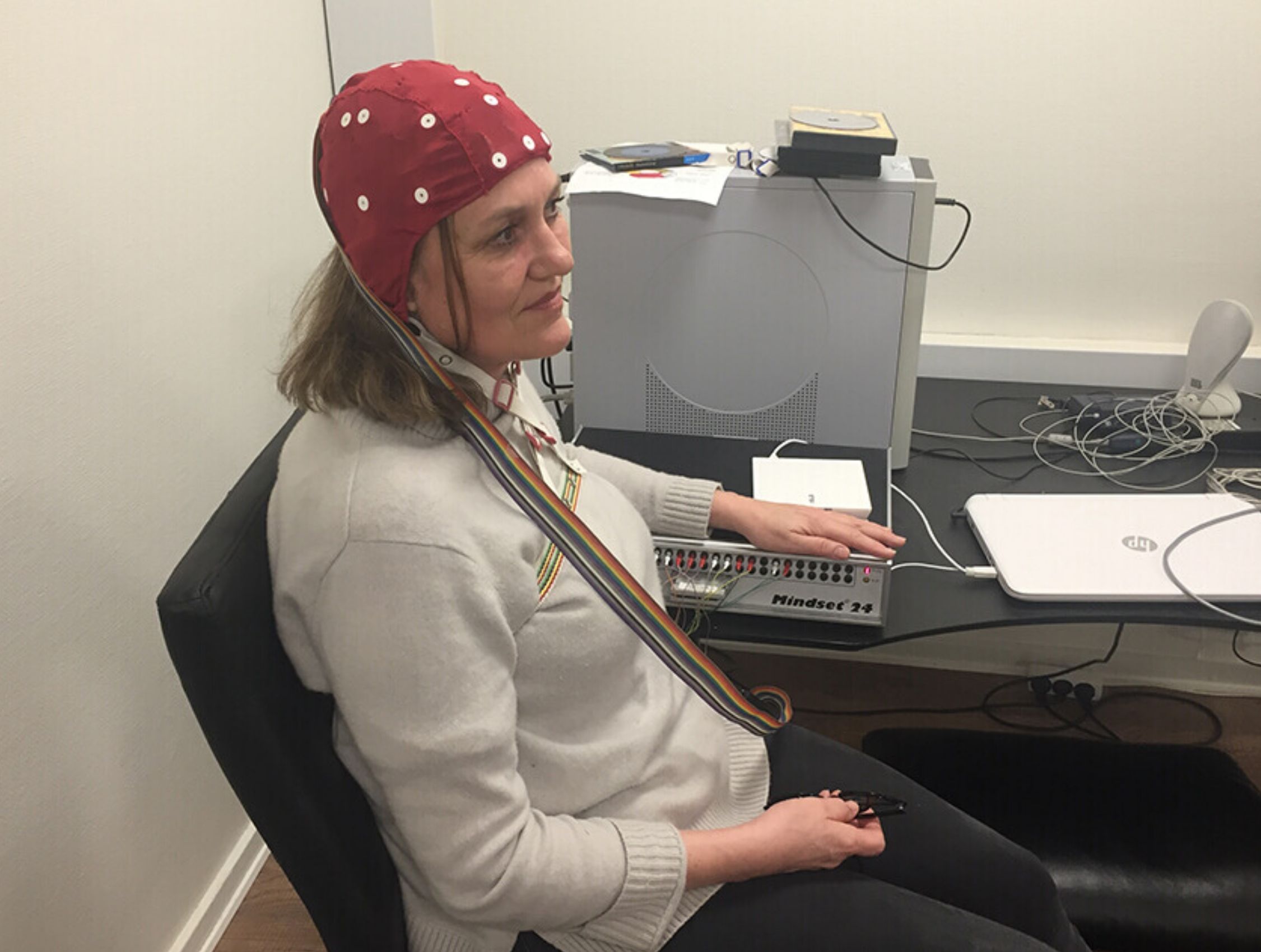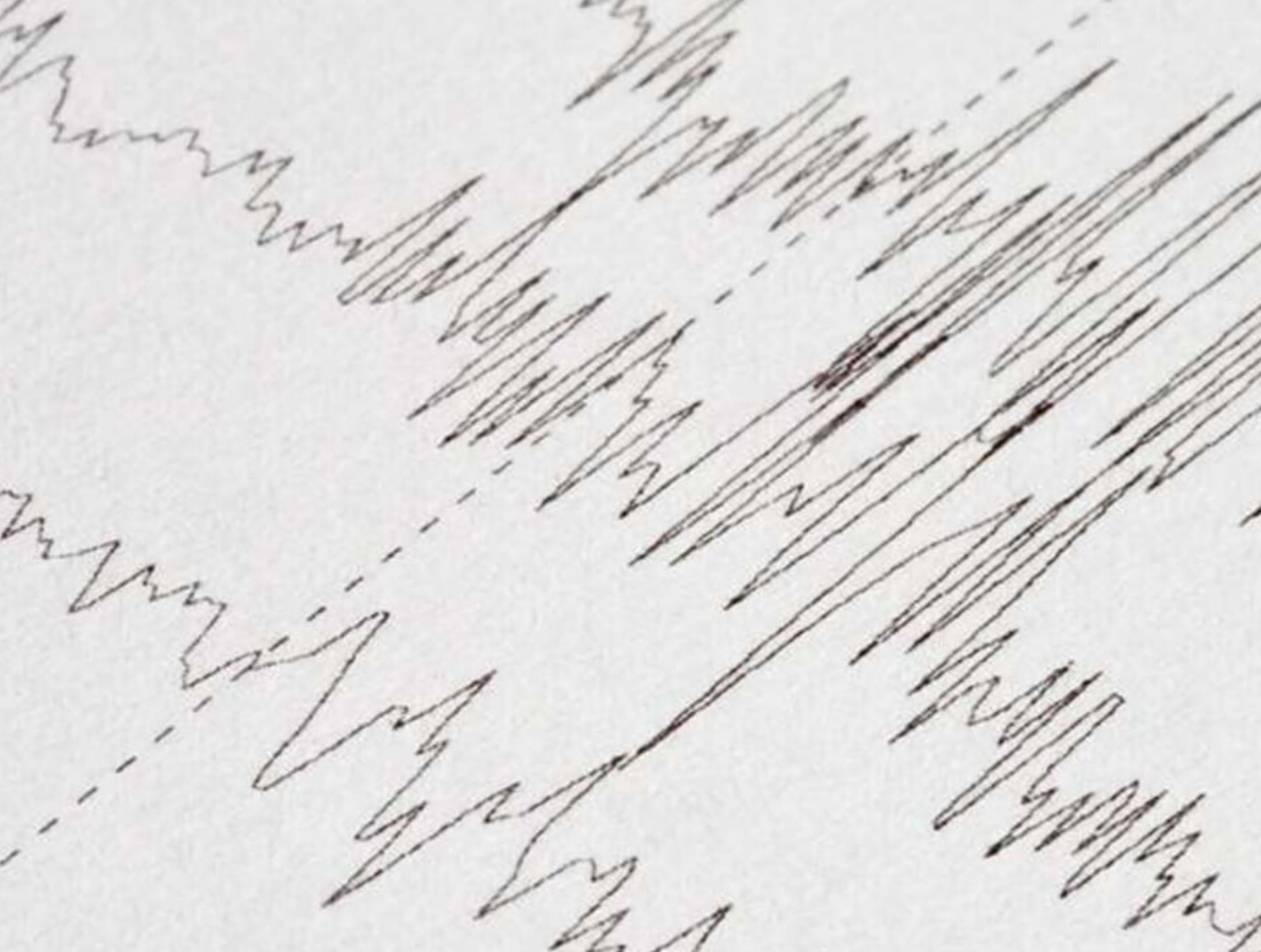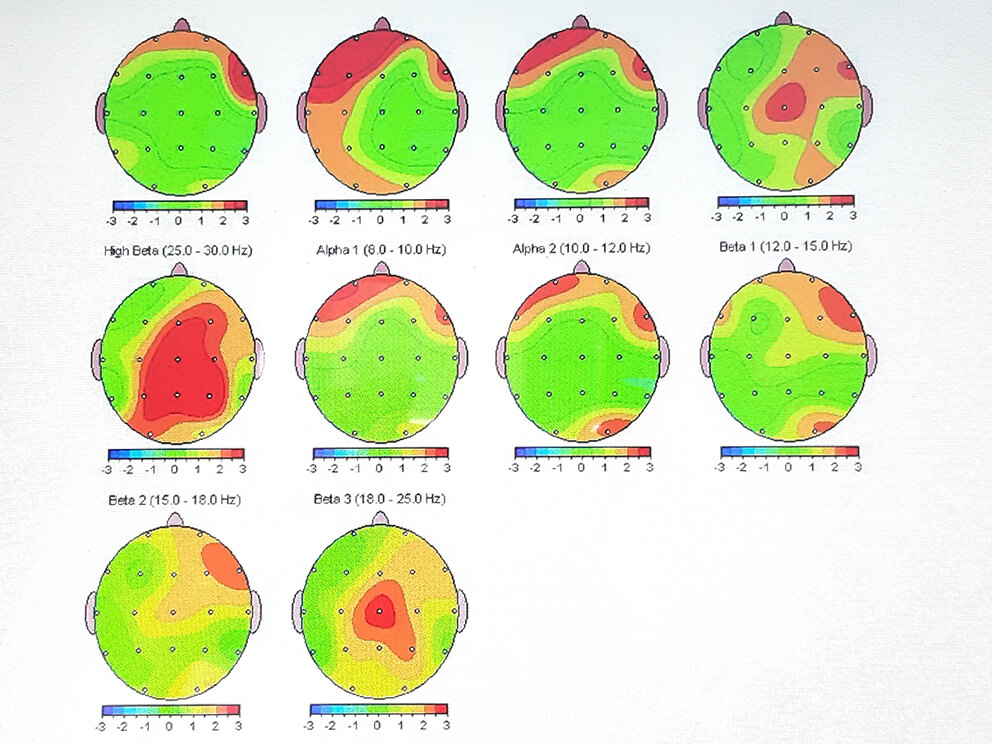Brain mapping with QEEG
What is QEEG brain mapping?
We use QEEG brain mapping to prepare your brain training. With QEEG brain mapping, we find out if you have too much activity or too little activity in 19 places in the brain – and whether you produce the right kind of brain waves, in the right places in the brain. We create a QEEG brain map to make your brain training as accurate as possible – so that you train towards achieving normal activity in the affected places in your brain.
For you to understand what a QEEG is, we have to start by describing what an EEG is. An electro-encephalogram (EEG) is a test that measures the electrical activity in the brain, using small metal discs (electrodes glued to the head).
Specifically, EEG activity is often measured with a cap on the head that has 19 (24) electrodes. The electrodes are distributed throughout the cap so that a large area of the brain is covered.


An EEG measures different types of brain waves. The result of an EEG is a printout with a series of curves which look like a pattern of zigzags
A QEEG calculates how much electricity comes out of the different brain waves. The brain waves are divided into 6 types:
- Delta waves – the slowest, and which dominate during deep sleep and in a coma
- Theta waves – which are dominant in the boundary between wakefulness and sleep
- Alpha waves – which are dominant during the awake state with closed eyes and during meditation
- SMR waves – which are associated with calm in the body, immersion, relaxed concentration and cognitive centering
- Beta waves – for concentration, mental activity and alertness
- High beta waves – which are seen with alertness and stress
All of these brainwave types “belong” to their respective emotional response to situations. If a person is met by a lion in a panic situation, they will usually make a lot of high beta waves. During focus, normally functioning people make beta waves. If instead, one produces theta waves in situations that require concentration and mental activity, it is a sign that the brain is not functioning properly. That’s how it is in general. It is, of course, the case that the brain uses different areas for different functions. Therefore, an EEG is measured in 19 different places for brain mapping.
Similarly, it is e.g. not appropriate if one produces beta activity when falling asleep. At this point it is better to have the brain in alpha activity, which is the idle(inactive) activity of the brain, and gradually fall into theta and delta activity, so that you eventually fall asleep. At the transition to deep sleep it is almost only delta waves that are being made.
How is QEEG brain mapping done?
During EEG measurement with the cap on, a software program captures the electricity from each of the 19 electrodes.
The Q in QEEG stands for the “quantitative“, amount of electricity. And the fact that you can measure the quantitative amount of electricity and compare with what is normal, means that you can make a map of the brain. It’s called a brain map.
What is a Brain map?
A brain map is a kind of map of the brain with different color indications for the amount of activity. It is the result of a QEEG measurement.
Special Brain mapping, suited for diagnosis and brain training
The Danish Institute for Brain Training uses a full two databases to ensure that your activity is kept up to normal: the Neuroguide database and the Loreta database.
Using the Neuroguide database, your local brain activities are compared with an age-based database that shows which brainwave types are normal, too high or too low under each of the 19 electrodes. If a person’s activity in front part of the brain after a concussion is too slow, this can be identified.
In the Loreta database, the EEG activity is transformed into scan-like images, by “brain mapping”. In this way the dysfunctional areas of the brain are revealed. For example, whether the excessive delta wave activity over the left temporal lobe originates from the amygdala.
Thus QEEG Brain Mapping is used for two things:
- Diagnoses made by doctors (we refer you to doctors who have used this for 30 years)
- Targeting brain training (targeting the places where you have deviations from the norm. No diagnosis is made.

QEEG is used by physicians to make diagnoses
In hospitals and outpatient neurology departments, an EEG is used to detect neurological disorders. It is often used to diagnose epilepsy and sleep disorders. In the United States, QEEG is also used in psychiatry and to see if there is a likelihood of minor brain damage or of ADHD.
QEEG is used for minor brain injury if no CT/MR scanners or SPECT are available
QEEG, when compared to the two databases, has certain advantages over an MRI scan or a CT scan. Minor and more diffuse damage, such as that seen in a concussion, cannot be seen by these standard scans CT/MR. On the other hand, they will be detected by functional measurements.
For brain diagnosis if SPECT scan is not possible
An QEEG brain mapping is a functional measurement where you are measured during function, i.e. while doing something. If you need to know your brain function and cannot perform a functional SPECT brain activity scan, QEEG is a cheaper but less precise alternative for examining brain function.
The benefit of QEEG brain mapping preparing for brain training at the “Department of Brain Training”
A QEEG BrainMap made on the basis of the Neuroguide database and the Loretta database provides much more accurate and effective brain training. This is the reason why you pay more for brain training at the Department of Brain Training.
Here, the neurofeedback training is held up against the QEEG after brain mapping. This ensures that only the frequencies (= wave types) that are too low are trained up, and frequencies (wave types) that are too high are trained down. In this way you make sure that you get to train the right places in the brain.
This is how you avoid incorrect training and overstimulation. The cheaper places do not do this. This, and the scientific background from Roskilde University, are the reasons why REbrain Clinic has chosen the Department of Brain Training as its partner.
Read about brain training